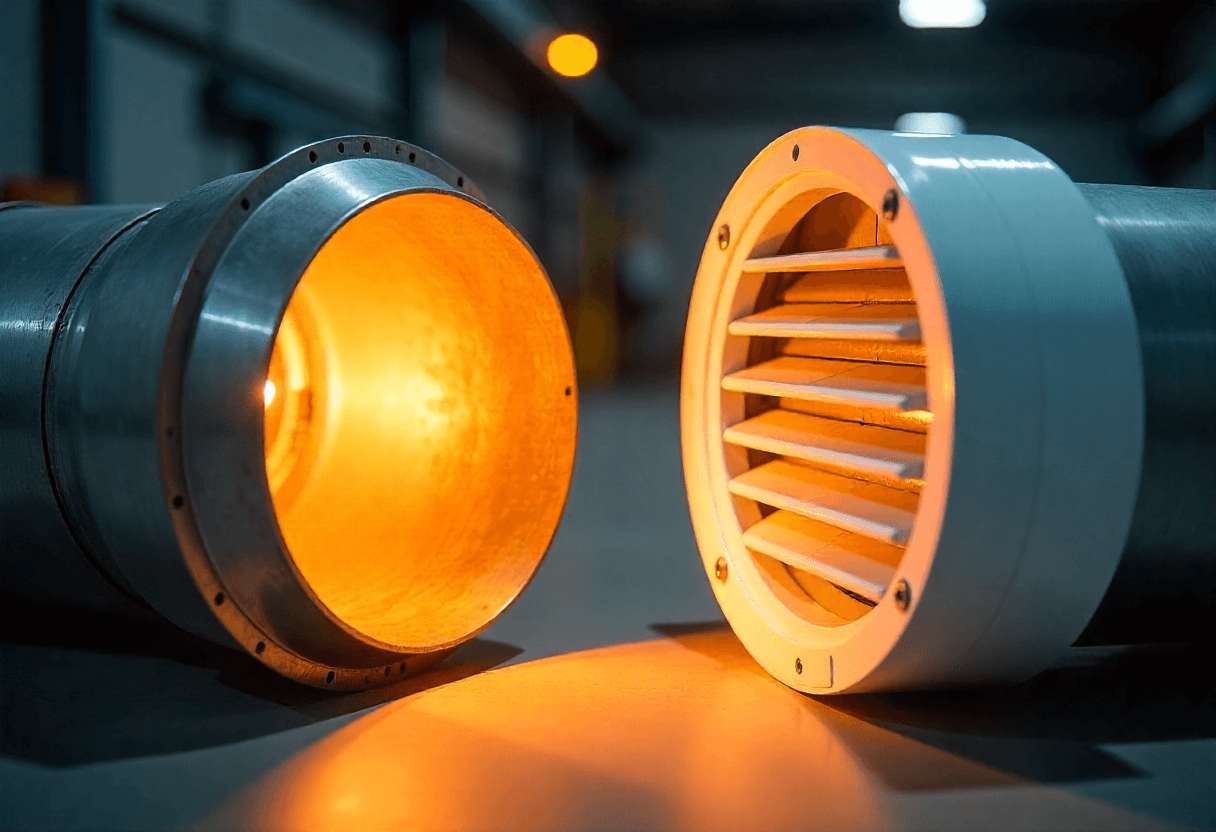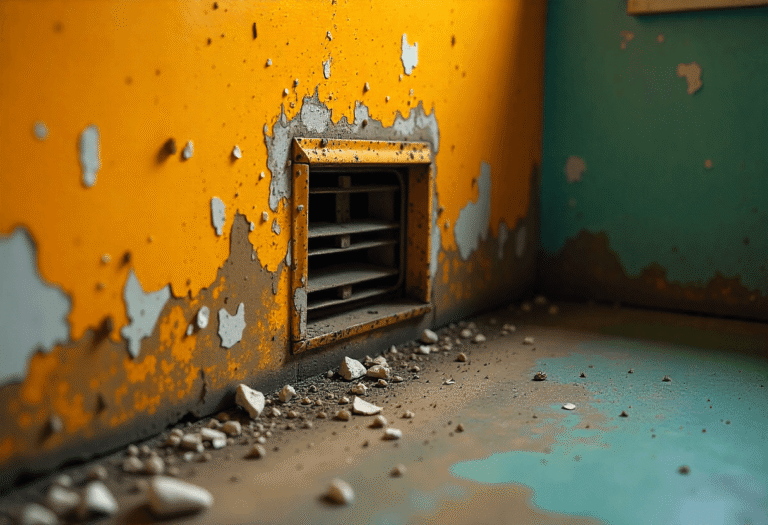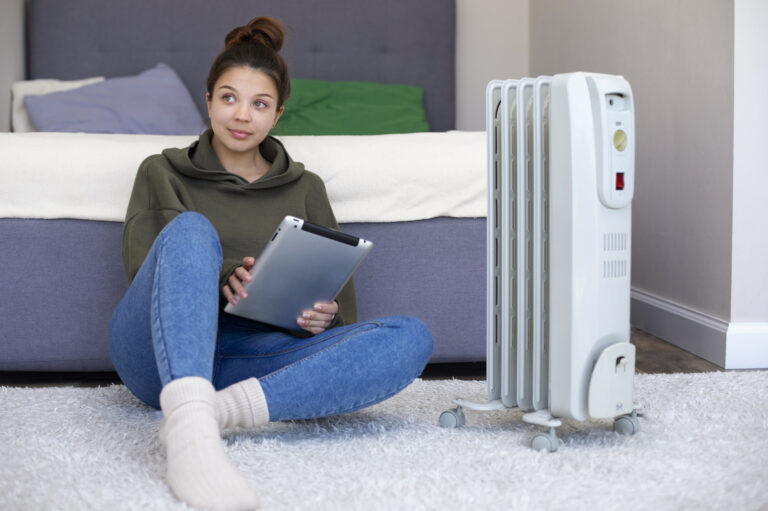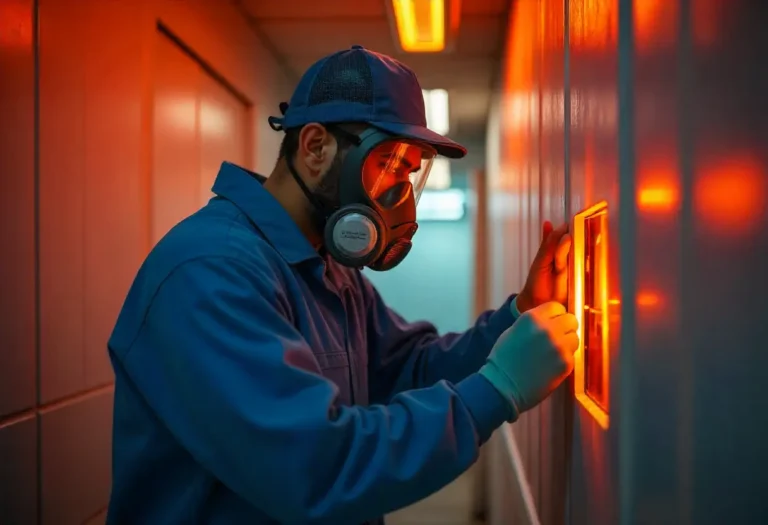A lot of homeowners use the words ducting and venting interchangeably, and it’s easy to see why. After all, both are connected to how air moves in and out of your home.
However, although they work together, they’re not the same thing.
But why does the difference even matter to you?
Well, it can explain why some rooms in your home feel stuffy while others are freezing, why your energy bills keep climbing, or why your bathroom always feels damp. Once you know the basics, it all makes perfect sense.
In this blog, I will break down all the differences between ducting and venting with real-life examples and HVAC system maintenance tips. You’ll learn:
- What is ducting and venting
- How to spot the difference
- How each one works
So, let’s get started.
Key takeaways
- Ducting moves heated or cooled air throughout your home.
- Venting removes stale air and brings in fresh air.
- Supply vents blow air in; return vents pull it back.
- Exhaust vents push out humidity, odors, and gases.
- Leaky ducts or poor ventilation can raise energy bills.
- Ductless systems don’t use ductwork at all.
- Closing vents doesn’t save energy; in fact, it can hurt efficiency.
- Both ducting and venting are essential for comfort and health.
Ducting and venting: What’s the difference?
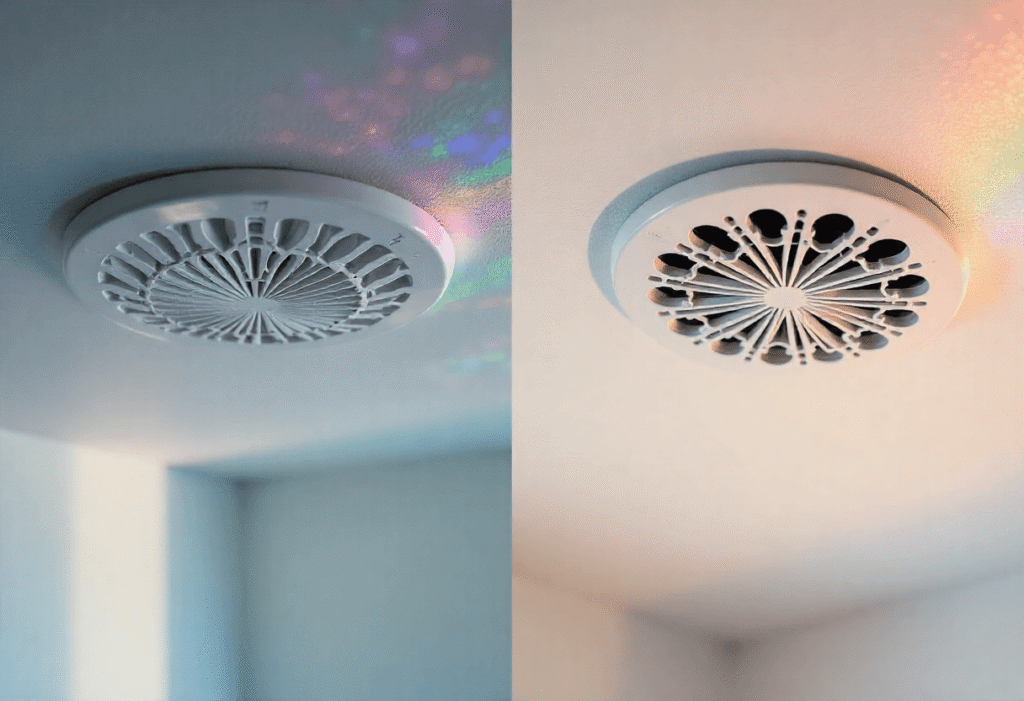
At first look, venting and ducting might look like the same thing since both work to move air in your home.
But they actually serve very different purposes. Here’s how:
- Ducting is the physical network of passages (usually hidden in walls, ceilings, or attics) that carries heated or cooled air from your HVAC system to different rooms.
- Venting is the process of letting air in or out of your home. This includes bringing in fresh outdoor air, removing stale indoor air, and removing harmful gases from appliances like your furnace or dryer.
Simply put, while ducting moves air around inside your home, venting ensures exchange of air between indoors and outdoors.
Both are equally important because:
- Ducting keeps your rooms comfortable
- Venting keeps the air you breathe safe and healthy
Here’s a quick comparison of ducting & venting:
| Feature | Ducting | Venting |
| Purpose | Circulates heated or cooled air inside the home | Exchanges indoor air with outdoor air |
| Visibility | Hidden behind walls, ceilings, floors | Visible as grilles or registers in rooms |
| Connected to HVAC | Yes | Some are connected (supply/return), some are independent |
| Example | Sheet metal ducts in attic | Bathroom fan, kitchen hood, dryer vent |
I’ve explained them both in detail below. Let’s have a closer look.
Schedule Your Free Estimate Today
Contact us to improve your indoor air
quality with our expert cleaning services in NJ.
What is ducting?
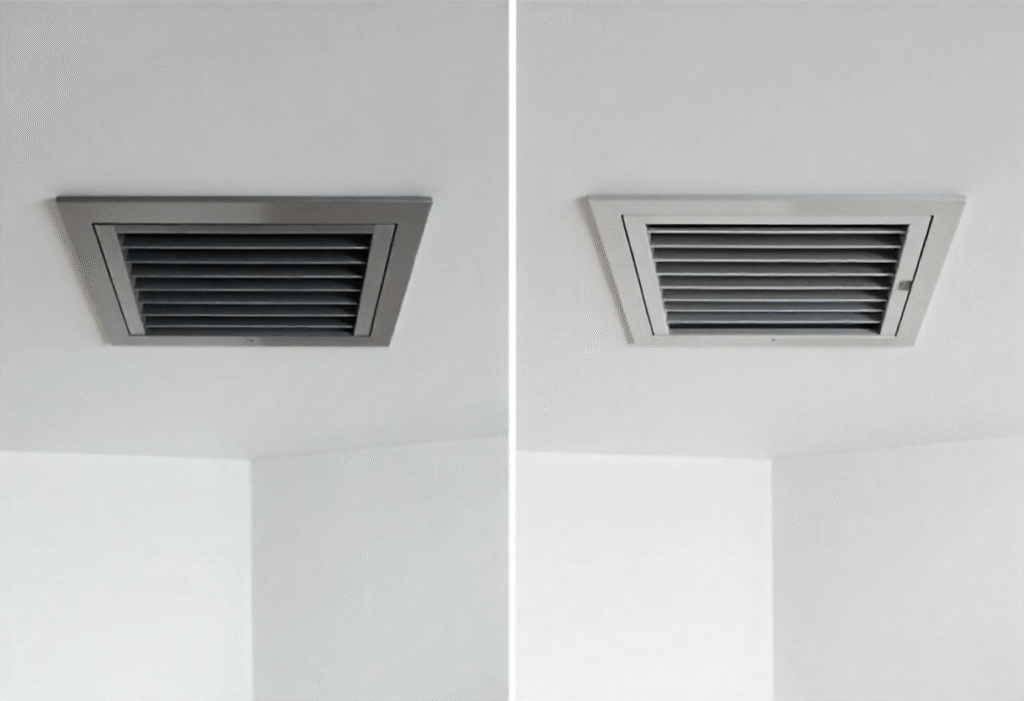
Ducting is the hidden network of tubes or channels that carries hot or cool air through your home.
Whenever you adjust your thermostat, your furnace or air conditioner pushes air into these ducts, which then deliver it to different rooms.
Talking about New Jersey homes, ducts made from sheet metal, fiberglass, or flexible plastic are common here. And they’re usually tucked away in attics, basements, crawl spaces, or behind walls.
In short, you can think of ducting as your home’s air delivery system.
What are the different types of ducts?
For starters, ducts aren’t just for blowing air into your living room or bedroom as they also pull back stale air.
You see, there are two types of ducts, namely:
- Supply ducts that bring fresh air from the HVAC system
- Return ducts that pull indoor air back to the HVAC system to be filtered, reheated, or cooled again
This cycle keeps the air circulating and the temperature balanced throughout your home.
| Duct Type | Function | Connected to HVAC? | Common Issues |
| Supply Ducts | Deliver warm or cool air to rooms | Yes | Leaks, crushed sections |
| Return Ducts | Pull air back to HVAC system | Yes | Blockages, dirty filters |
How does ducting work?
The way ducting works is fairly straightforward. Here’s a step-by-step look at how your HVAC system uses ductwork to keep your home comfortable year-round.
1. Air is heated or cooled
Your HVAC system works to either heat or cool the air, depending on how you adjust your thermostat.
For instance, if it’s cold outside, your furnace kicks on to warm the air. Similarly, if it’s hot, your air conditioner or heat pump cools it down.
2. The blower pushes the air
Once the air reaches the right temperature, the blower gets to work and pushes warm or cool air into your ductwork.
3. Air travels through ducts
After the blower kicks in, the air moves into a network of supply ducts. These ducts are often behind walls, above ceilings, or under floors.
4. Air enters your rooms
The air finally reaches the rooms in your home through supply vents. These vents are usually in walls, ceilings, or sometimes in the floor.
You’ll feel warm or cool air blowing out of them when your HVAC system is running.
Pro tip: If one room feels less comfortable than the others, it could be a sign of a ducting issue like a blockage or leak.
5. Return ducts pull air back
Once the air has circulated in your room, it doesn’t just stay there. Instead, it’s drawn back into the system through return ducts. These ducts pull in the used indoor air so it can be filtered, reconditioned, and sent out again.
6. The cycle repeats
This entire process happens continuously while your system is running. The air is pulled back, cleaned through air filters, warmed or cooled again, and then sent back through the ducts.
When everything is working right, it’s a smooth, efficient cycle that keeps your home comfortable and your indoor air healthy. But if there are leaks, clogs, or disconnected ducts, you should get a thorough air duct cleaning or it can throw the whole system off.
Here’s how ducting works step-by-step
| Step | What Happens |
| 1. Air is conditioned | HVAC heats or cools air depending on thermostat setting |
| 2. Blower activates | Blower fan pushes air into supply ducts |
| 3. Air travels | Conditioned air moves through hidden ducts |
| 4. Air enters rooms | Air comes out of supply vents into your living spaces |
| 5. Air is pulled back | Return vents collect used air and send it back to the HVAC |
| 6. Cycle repeats | Air is re-filtered, reconditioned, and circulated again |
What is venting?
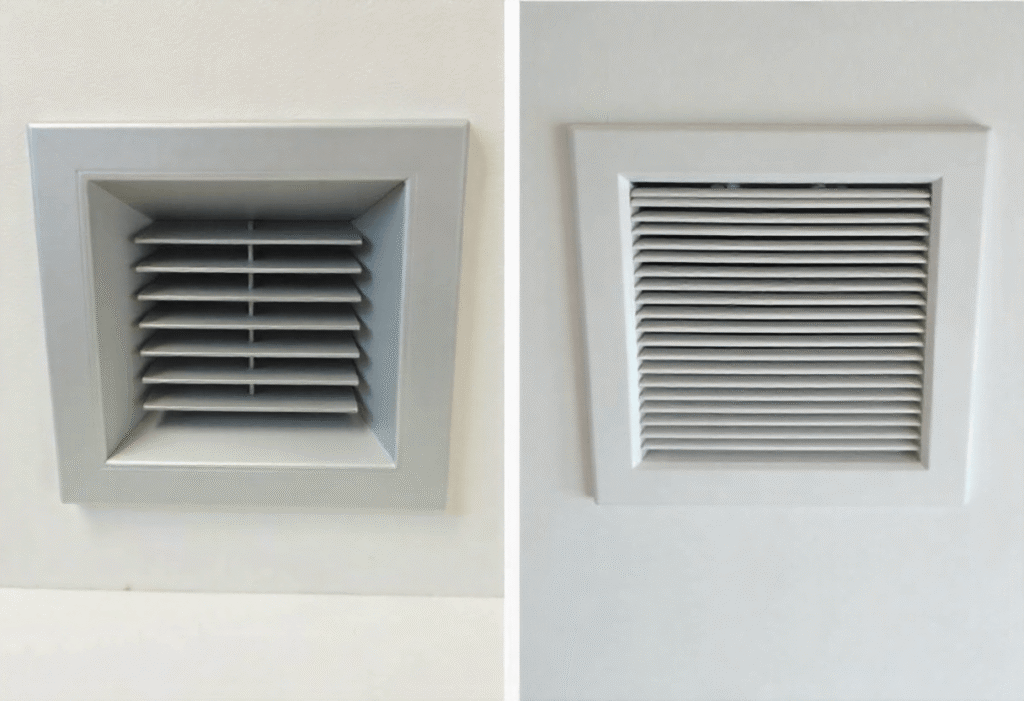
Venting is all about exchanging air. It brings fresh air in and pushes unwanted air out.
Also, unlike ducting, which mainly circulates heated or cooled air inside your home, venting works to maintain indoor air quality too.
SImply put, venting keeps your indoor air fresh, removes moisture and odors, and protects your family from harmful pollutants or gases.
What are the different types of vents?
There are a few different types of vents working behind the scenes to keep your air clean, comfortable, and safe.
Here, each vent type plays a distinct role. And while some work with your HVAC system, others operate independently.
Let’s have a look at the most important ones:
1. Supply vents
These vents are connected to your HVAC system and they blow warm or cool air into your rooms.
You’ll typically find them on the floor, walls, or ceiling. And when your HVAC is running, these are the vents you’ll feel air coming out of.
2. Return vents
Return vents pull air from your rooms back into the HVAC system to be filtered and conditioned again. These vents help keep the air moving in a continuous loop.
Your home might have one big return vent in the hallway or several smaller ones in different rooms.
3. Exhaust vents
These vents aren’t connected to your heating and cooling system. Instead, they’re used to get rid of unwanted air.
So, whether it’s moisture from your bathroom, smoke from cooking, or heat from your dryer, exhaust vents push that stale or damp air outside. And this is crucial to preventing problems like mold or poor indoor air quality.
| Vent Type | Function | Location | Connected to HVAC? | Example |
| Supply | Push warm/cool air into rooms | Floors, walls, ceilings | Yes | Floor register, diffuser |
| Return | Pull air back into the HVAC system | Walls, ceilings, central halls | Yes | Return grille, filter grille |
| Exhaust | Remove stale, moist, or polluted air from home | Bathrooms, kitchens, laundry | No (vents outside) | Bathroom fan, dryer vent |
How does venting work?
Venting works by moving stale, humid, or contaminated air out of your home and replacing it with cleaner air.
Here’s what does a vent do:
1. Air is collected
Fans, vents, or openings gather indoor air that needs to be removed like steam from a shower, smoke or odors from cooking, or gases from a furnace.
2. Air is pushed out
The air is then sent outdoors through an exhaust vent, flue, or duct.
3. Fresh air replaces it
Fresh outdoor air is brought in mechanically through a dedicated system like an HRV (heat recovery ventilator) or ERV (energy recovery ventilator).
Here’s how venting works step- by-step
| Step | What Happens |
| 1. Air is collected | Fans or vents gather indoor air (steam, smoke, gas) |
| 2. Air is expelled | Air is pushed out through exhaust vents, ducts, or flues |
| 3. Fresh air comes in | Outdoor air enters through mechanical systems or open windows |
How to tell what’s duct and what’s vent?
It is easy to confuse ducts and vents since they’re both part of the same system. But here’s how you can quickly tell them apart:
- Ducts are hidden: They’re the channels behind your walls, ceilings, attic, or basement. So, unless you’re doing construction or looking into an unfinished space, you usually won’t see them.
- Vents are visible: These are the grilles or covers you see on your walls, floors, or ceilings. They’re the points where air enters or leaves a room.
Conclusion
HVAC vent and duct might sound similar, but they’re completely different.
- Ducting is the network that moves heated or cooled air around inside your home.
- Venting is about exchanging air, bringing fresh air in, pushing stale or humid air out, and safely exhausting gases.
Both work hand in hand to keep your home comfortable, efficient, and safe.
Got more questions or want to schedule a full HVAC maintenance?
You can get in touch with us!
At Clean Air Technologies, we are seasoned HVAC service professionals with three decades of hands-on experience serving all of New Jersey. And from duct and vent upkeep to HVAC efficiency and indoor air quality, we’ve got it all covered for you on a budget.
Schedule Your Free Estimate Today
Contact us to improve your indoor air
quality with our expert cleaning services in NJ.
FAQs about ducting and venting
Do ductless systems have ducts or vents?
No, ductless systems like mini-splits don’t use ducts at all. Instead, they blow conditioned air directly into a room through a wall-mounted unit.
They still have an outdoor unit and refrigerant lines, but no ducting is needed here.
How often should your ducts be inspected or sealed?
It’s a good idea to have ducts checked every one or two years. If your home is older, you notice uneven airflow, or your energy bills are unusually high, sealing and insulating your ducts can make a big difference.
Is duct cleaning the same as dryer vent cleaning?
Not at all.
Duct cleaning involves removing dust and debris from your HVAC system’s ductwork.
Dryer vent cleaning, on the other hand, involves removing lint buildup from the vent pipe that carries air from your clothes dryer outside.
Can closing vents save energy?
No.
In fact, it can cause problems. Closing vents increases pressure in your ducts, which can lead to leaks and reduce efficiency.
So, it’s better to keep vents open and let your system balance airflow as designed.
What’s the difference between a vent register and a grille?
Both are types of vents you see in your living space.
A register is a vent cover with an adjustable damper, so you can control how much air comes out.
A grille is a simple cover with no damper, usually found on return vents.

